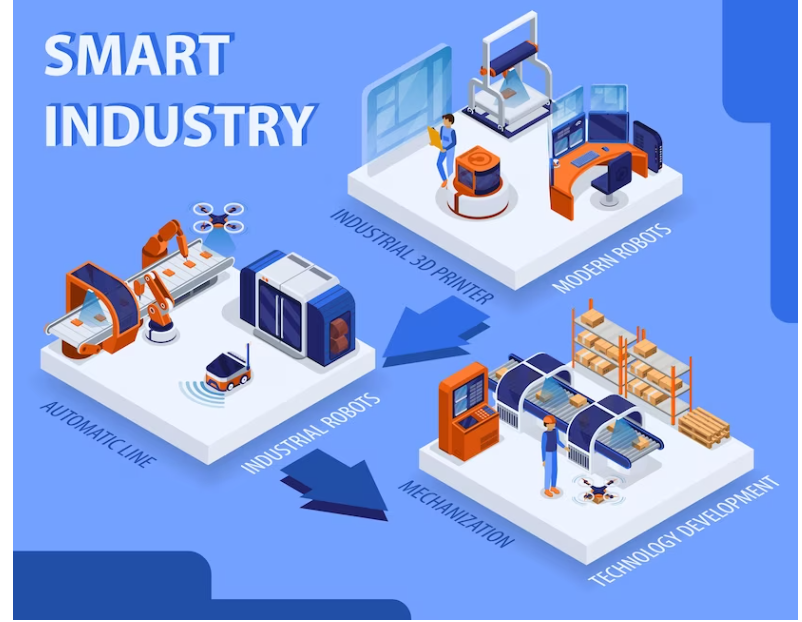In the present quickly developing technological landscape, the Internet of Things (IoT) has arisen as an extraordinary power with the ability to reshape enterprises and make them ready for smarter, more productive urban communities. IoT, at its centre, alludes to the interconnected organization of gadgets, sensors, and frameworks that convey and trade information through the web. This innovation is assuming a critical part in revolutionizing industries overall and is driving the idea of shrewd urban communities or smart cities into the real world.
IoT applications in the industry
Industrial are encountering a change in perspective as IoT advancements penetrate different areas. In assembling, for example, the Industrial IoT (IIoT) is introducing another time of functional or operational efficiency. By coordinating sensors and savvy gadgets across the assembling system, organizations can screen gear wellbeing, streamline creation work processes, and upgrade generally speaking efficiency. This has brought about the idea of smart production lines or factories, where ongoing information investigation or data analysis and machine-to-machine communication empower consistent coordination and decision-making.
Revolutionizing Supply Chain Management and Predictive Maintenance
The effect of IoT reaches out past the manufacturing plant floor. Supply chain management The board has seen a critical update through the execution of IoT-empowered tracking and checking. Organizations can now screen the development and condition of products all through the supply chain, guaranteeing transparency, minimizing misfortunes or losses, and reducing delays.
Predictive management is one more remarkable use of IoT innovation. By furnishing hardware with sensors that assemble information on execution and health, associations can predict potential failures and timetable maintenance before expensive breakdowns happen. This proactive approach forestalls free time as well as augments the life expectancy of equipment, prompting significant expense reserve funds or cost savings.
Energy Utilization and Smart Cities
In the domain of energy utilization, IoT assumes a vital part in optimizing consumption and advancing manageability. Brilliant systems fueled by IoT sensors empower real-time monitoring of energy circulation, permitting utilities to change supply according to demand fluctuation. This further develops effectiveness as well as lessens wastage and advances the integration of sustainable energy sources.
The idea of smart city areas epitomizes the maximum capacity of IoT applications. Through an organization of interconnected gadgets and systems, urban communities can upgrade administrations or services, smooth operations, and work on the personal satisfaction of residents. Waste management, for example, can be changed by sending smart bins furnished with sensors that screen fill levels and optimize trash collection routes.
Efficient Traffic Management and Environmental Monitoring
Smart traffic to the executives is one more feature of IoT execution in smart cities. By using ongoing information or data from sensors implanted in streets, vehicles, and traffic lights, cities can ease blockage, upgrade traffic flow, and reduce carbon emissions. This reduces commuting times as well as adds to a cleaner, more reasonable urban environment.
Environmental monitoring is additionally reinforced by IoT innovation. Sensors conveyed all through a city can measure air quality, noise levels, and other environmental boundaries, empowering specialists to go with informed choices to work on general health and prosperity.
Addressing Challenges of IOT applications in industry and Paving the Way Forward
Regardless of its transformative potential, IoT isn’t without challenges. Security and privacy concerns pose a potential threat, as the interconnected idea of gadgets or devices increases the risk of information or data breaks and unapproved access. To overcome these difficulties, robust encryption, verification conventions, and normal updates are fundamental. Also, rigid information security guidelines should be complied with, ensuring that user data is taken care of capably and transparently.
The future fate of IoT applications is promising. As innovation keeps on advancing, the coordination of IoT with man-made reasoning (artificial intelligence) is set to make a much more smart and independent system. Artificial intelligence calculations can investigate huge measures of IoT-produced information to separate significant bits of knowledge, extract valuable insights, personalized services, and more effective decision-making.
IoT and Edge Computing
IoT’s advantageous connection with edge computing is fundamental to its proceeded with development. Edge computing includes handling information nearer to its source, reducing latency, and enabling faster reaction times. This is particularly basic in situations where real-time activities are required, like independent vehicles or critical industrial processes.
CONCLUSION
All in all, the capability of IoT applications in industry and smart cities is colossal. From revolutionizing manufacturing and supply chain management to changing cities into interconnected centres of proficiency, IoT is reshaping the world as far as we might be concerned. While challenges exist, the progressions or advancement in safety efforts and the joining of artificial intelligence and edge computing promise a future where IoT-driven development keeps on flourishing, making our industries more intelligent and our cities more sustainable.
Hope You found this article informative. Thanks for Reading, We also have an article on home automation using IOT. Please go through it, you may find it useful.
The Internet of Things (IoT) refers to an organization of interconnected actual gadgets, sensors, and frameworks that impart and trade information over the Internet. These gadgets gather and communicate information, empowering remote checking, control, and computerization of different cycles and functions.
IoT is changing industries by enabling constant information assortment, examination, and decision-making. It upgrades functional or operational effectiveness, decreases margin time, streamlines supply chains, and works on efficiency. Enterprises are embracing IoT to acquire experiences, improve processes, and make inventive plans of action or business models.
IoT applications in manufacturing include prescient maintenance, real-time checking of equipment and creation processes, inventory administration, and quality control. These applications further develop production efficiency, minimize personal time, and enhance item quality.




